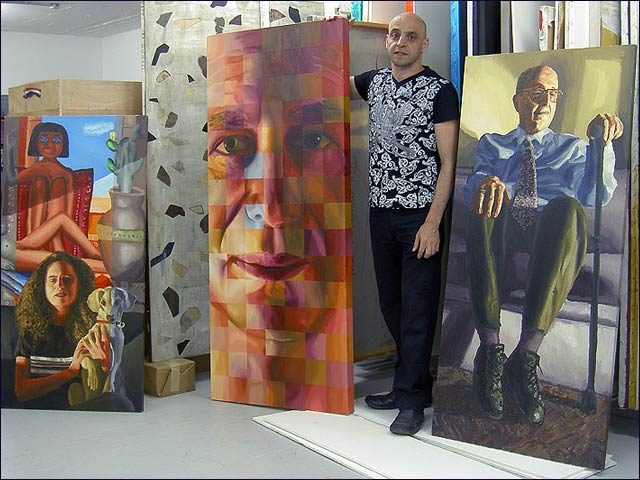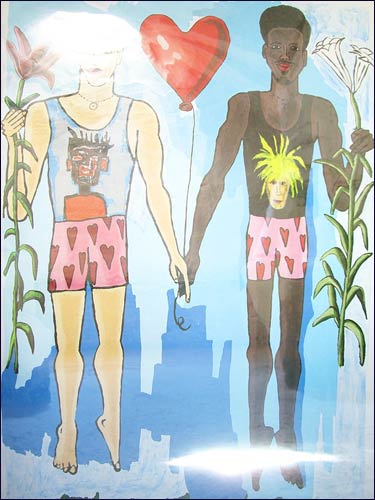By Abigail Klein Leichman
On now-tattered diary pages spanning his teens to twenties, Jerusalem-born
Rafael Perez poured out his inner conflict over his homosexual feelings. And then he drew over the Hebrew words with colored pencil.
“I was afraid of my homosexuality. So I covered the words with drawings because I didn’t want people to see what I wrote,” he explains. “This was a very emotional period.”
Today, the openly gay artist symbolizes the open and free atmosphere of Tel Aviv that is attracting a steady stream of gay, lesbian, bisexual and transgender (GLBT) tourism.
He was the sole artist chosen for a Tourism Ministry campaign, featuring eight Israelis from the fields of sports and culture, which is splashed across London’s billboards, newspapers and magazines. Now in its second year, the campaign has helped boost attendance at Tel Aviv’s annual Gay Pride Parade and Gay Pride week activities to more than 100,000 visitors in the past two years.
“My agenda is about gay life -- that it’s okay to be gay, to live your life, to find your love,” he says.
Red hearts and rainbow flags figure prominently in his vibrant, large canvases celebrating heterosexual and homosexual love in a professional childlike style called “naïve.” Many of his works celebrate Tel Aviv itself, which has an estimated 20 percent GLBT population.
“My art is a reflection of the entire gay community -- people in the closet, mature love, gay families, gay political and cultural icons,” Perez says during an interview in his spacious studio-slash-residence above a mechanic’s garage in industrial South Tel Aviv.
Perez lives in his studio in South Tel Aviv
Imagining gay families
Born in 1965 to a traditional family, Perez and his two brothers were exposed to works of great painters, and each became an artist in his own way. One brother is an industrial designer and the other designs jewelry. But Perez didn’t intend to make his living as a painter.
Like other young Israeli men, he served three years in the military, all the while pursuing relationships with women. He then worked as a counselor for 15 years at a residential facility for kids from abusive homes. He also taught preschool sports and art, and at 23 enrolled in a Beersheva art school, where he honed his two styles: naïve and realistic.

Perez’s realistic style
He was 32 before he fully embraced a gay lifestyle. “It wasn’t like today, when kids come out of the closet at 15 or 16,” he says.
“I didn’t become gay all of a sudden one day. I really wanted to be successful in my relationships with women, and you can see that in my paintings from that time. My paintings helped me understand what I was feeling. People say my artwork is very happy and they don’t see my conflict with homosexuality. The truth is I was happy when working with the children, and that gave me the happiness you can see in my naïve-style art.”
His more recent series are truly conflict-free. “Gay Love Black & White,” for example, celebrates his much-publicized relationship with an Eritrean refugee, which lasted for 11 months. Another imagines Tel Aviv as an Amsterdam-like magnet for nightlife and Jerusalem as a multicultural focal point for the whole world.

“Gay Love Black & White”
Perez began painting gay families in 2000, inspired not by real-life scenes but by his imagination. That year, both his heterosexual twin brother and his ex-girlfriend had their first babies.
“I became involved with the upbringing and care of the babies, and this prompted me to start painting situations that involve gay families,” says Perez. “I was one of the few painters that dealt with this issue at that time.”

Perez’s works often depict gay families
These paintings, as well as a series from 1999 anticipating a “golden age” of gay life in Israel’s second largest city, were ahead of their time and came to symbolize an open and growing trend in Tel Aviv and elsewhere.
An Internet artist
Type “gay artist” in Arabic into a Google search, and Perez’s paintings pop up first. Though his paintings are exhibited in galleries and ad campaigns in several countries – his most recent show was in Palm Springs, California -- he considers himself an Internet artist who uses YouTube, Facebook and Flickr to display his works to millions of viewers.
This has had a profound effect on secretly gay residents of countries that don’t condone such a lifestyle.
“Many people write to me after they see my paintings all over the world, even Arabs in Syria and many other countries,” says Perez. “They tell me, ‘We see your stuff and now we believe there could be love.’”
He is pleased that his paintings have served as a visual advertisement for Tel Aviv, which has become a separate “brand” in tourism apart from the rest of Israel.
“Gay tourists invest much more than heterosexual tourists, maybe because they are usually childless,” Perez says. “They spend a lot at bars and restaurants in Tel Aviv.”
These same visitors to Israel exemplify his wider audience. “Most of my customers invest in art,”
he says. “I owe my life to the gay community and I made my will to give back my paintings to the gay community.”